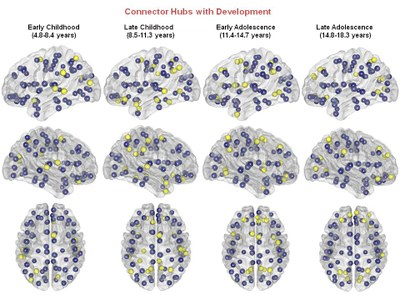Segregation and Integration of Cortical Connections in the Developing Brain
Budhachandra Khundrakpam (McConnell Brain Imaging Center, Montreal Neurological Institute, McGill University, Montreal, Canada), Andrew Reid (McConnell Brain Imaging Center, Montreal Neurological Institute, McGill University, Montreal, Canada), Jens Brauer (Max Planck Institute for Human Cognitive Sciences, Leipzig, Germany), Junki Lee (McConnell Brain Imaging Center, Montreal Neurological Institute, McGill University, Montreal, Canada), Felix Carbonell (McConnell Brain Imaging Center, Montreal Neurological Institute, McGill University, Montreal, Canada), Gaolang Gong (McConnell Brain Imaging Center, Montreal Neurological Institute, McGill University, Montreal, Canada), Zhang Chen (McConnell Brain Imaging Center, Montreal Neurological Institute, McGill University, Montreal, Canada), Yong He (State Key Laboratory of Cognitive Neuroscience & Learning, Beijing Normal University, Beijing, China), Alan Evans (McConnell Brain Imaging Center, Montreal Neurological Institute, McGill University, Montreal, Canada)
Introduction
During development, the structural and functional connectivity of the human brain changes dramatically. Brain imaging studies have shown widespread changes in grey matter during adolescence most notably, an increase of grey matter during adolescence followed by a decrease which has been proposed to reflect synaptic pruning. However, the processes through which neural networks are reorganized during developmental periods are still poorly characterized. In this study, we try to address this issue by looking at structural brain networks based on cortical thickness on a large population of normally growing children with age range from 4.8 to 18.3 years. We observed the maturational processes of segregation and integration of cortical connections using graph-theoretic tools and inter-regional connectivity analysis.
Methods
For the study, we analyzed brain images of 203 children (age: 4.8 to 18.3 years) from the NIH-MRI study of normal brain development database. To investigate developmental changes, we divided the population sample into 4 groups (Early Childhood: n=51, age: 4.8-8.4 years; Late Childhood: n=51, age: 8.5-11.3 years; Early Adolescence: age: 11.3-14.7 years; Late Adolescence: n=50, age: 14.8-18.3 years). Using the structural MRI images, cortical thickness was computed at 78 regions which were based on the automatic anatomical labelling (AAL) template, and two regions were considered connected if the group-wise correlation in cortical thickness between the two regions exceeded a threshold. The resulting 78 × 78 binary connection matrix defined a network graph for each group, and the topological properties of these networks were analyzed using a number of graph theoretical measures, namely: clustering coefficient, shortest path length, global and local efficiency, and modularity. Once modules are identified, connector hubs (nodes with maximum links to other modules) are computed for network of each age group. In order to investigate regional changes in connectivity, brain regions are divided into functional divisions, namely: primary sensory and motor, limbic, paralimbic and association regions; and inter-regional connectivity difference between age groups are determined.
Results
Small world behaviour, characterized by clustering coefficient and shortest path length, was seen for all age groups in the sparsity range of 8-30%. Statistical comparisons using 1000 bootstrap samples for each age group showed an interesting pattern. The clustering coefficient is significantly reduced (p < 0.05) in the late childhood (8.5-11.3 years) suggesting a decrease in local connections. There was also significant decrease (p < 0.05) in shortest path length in the late childhood. We also observed a corresponding decrease (p < 0.05) in network modularity in late childhood, suggesting a less modular (well-distributed) organization during this age range. The number of connector hubs are increased and widely distributed in late childhood; by the end of adolescence, they are restricted and localized to higher order association areas in frontal and parietal cortices. Inter-regional connectivity analysis based on correlations revealed that primary-limbic and primary-paralimbic connectivity are well-established by early childhood while higher-order association and paralimbic connectivity continue increasing during development. These results were also seen with graph-theoretic measures; regional efficiency of primary regions is highest in early childhood and decreases with development while that of association regions continues increasing.
Conclusions
Structural brain networks inferred from cortical thickness measurements of brains of children and adolescents, revealed a unique developmental pattern; late childhood (8.5-11.3 years) showed an extensive organizational change; a decrease in clustering coefficient, a decrease in shortest path length and a decrease in modularity. Together, these results suggest a more distributed and efficient reorganization during the late childhood. Adolescent age groups become more modular, and specific neural pathways especially the higher-order association regions and paralimbic regions become more strongly connected and efficient. Our results give credence to the theory of segregation and integration which continue refining cortical connections during development.


 Latest news for Neuroinformatics 2011
Latest news for Neuroinformatics 2011 Follow INCF on Twitter
Follow INCF on Twitter
